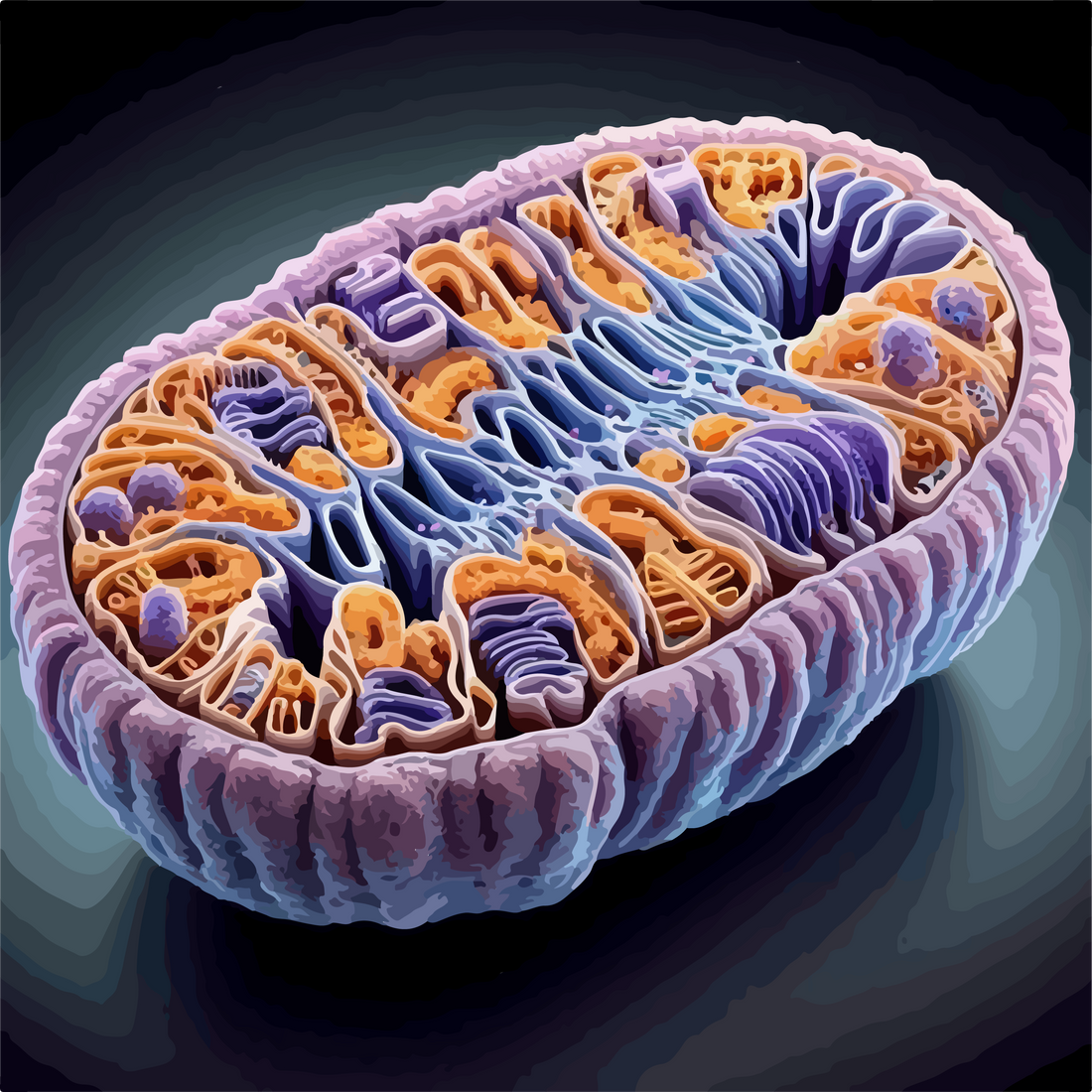Discover Related Products
Now explore supplements designed to support Longevity, Gut Health & Cellular Vitality.
CITOZYM - Support Natural Detox, Immune and Longevity Support
Mitochondria: The Powerhouses of Life

Table of Contents
- Introduction to Mitochondria
- Structure and Function of Mitochondria
- Energy Production
- Additional Functions of Mitochondria
- Mitochondria and Aging
- Mitochondrial Diseases
- How to Keep Mitochondria Healthy
- Conclusion
- References
1. Introduction to Mitochondria
Mitochondria are essential organelles found in nearly all eukaryotic cells, often referred to as the "powerhouses" of the cell. Their primary role is to produce adenosine triphosphate (ATP), the molecule that provides energy for most cellular activities. However, mitochondria also perform other critical functions, including regulating calcium metabolism and modulating programmed cell death (apoptosis). Their significance to life is profound; mitochondrial dysfunction is linked to a wide range of diseases, from premature aging to neurodegenerative disorders.
2. Structure and Function of Mitochondria
Mitochondria are double-membraned organelles with a unique structure crucial to their function. The outer membrane is smooth and acts as a protective barrier, while the inner membrane is highly folded, forming cristae that increase the surface area available for vital biochemical processes like oxidative phosphorylation [1].
Inside the inner membrane is the mitochondrial matrix, a space containing enzymes, mitochondrial DNA (mtDNA), ribosomes, and other molecules necessary for ATP production. Mitochondria are the only organelles, aside from the nucleus, to possess their own DNA, which is maternally inherited and encodes some of the proteins essential for mitochondrial function [2].
3. Energy Production
The primary function of mitochondria is to produce ATP through a process known as oxidative phosphorylation, which takes place in the inner mitochondrial membrane. During this process, electrons derived from nutrient breakdown are transported along a series of protein complexes known as the electron transport chain. This electron transfer creates a proton gradient that powers the ATP synthase enzyme, responsible for synthesizing ATP. This process is critical for maintaining cellular functions, as ATP is the cell's main energy source [3].

4. Additional Functions of Mitochondria
Beyond energy production, mitochondria perform many other essential functions:
-
Regulation of Calcium Metabolism: Mitochondria store and regulate the release of calcium ions, which are vital for numerous cellular functions, including muscle contraction and intracellular signaling [4].
-
Heat Production: In certain types of cells, such as those in brown adipose tissue, mitochondria are involved in thermogenesis, a process that generates body heat to maintain core temperature [5].
-
Apoptosis: Mitochondria play a central role in apoptosis, the process of programmed cell death. This is crucial for eliminating damaged or infected cells and maintaining cellular homeostasis [6].
5. Mitochondria and Aging
Mitochondria are also closely linked to the aging process. The mitochondrial theory of aging suggests that accumulated damage to mitochondrial DNA and proteins, primarily due to reactive oxygen species (ROS) produced during oxidative phosphorylation, leads to a decline in mitochondrial function over time. This reduction in mitochondrial efficiency contributes to decreased cellular energy, promoting aging and the onset of age-related diseases such as Parkinson’s, Alzheimer’s, and heart disease [7].
6. Mitochondrial Diseases
Mitochondrial dysfunction is at the root of numerous genetic diseases, known as mitochondrial diseases, which can affect various systems in the body. These diseases result from mutations in mitochondrial DNA or nuclear DNA that encodes mitochondrial proteins. Symptoms of mitochondrial diseases vary widely and can include muscle weakness, heart problems, neurodegeneration, and metabolic disorders. Mitochondrial diseases are often difficult to diagnose, and currently, there is no definitive cure, although research is exploring new therapies and treatments [8].
7. How to Keep Mitochondria Healthy
Maintaining mitochondrial health is crucial for overall well-being and disease prevention. Here are some science-backed tips to support mitochondrial health:
Regular Physical Exercise
Physical activity, particularly aerobic exercise and high-intensity interval training (HIIT), is one of the most effective ways to stimulate mitochondrial biogenesis, which is the production of new mitochondria. This type of exercise also improves the efficiency of existing mitochondria, enhancing the body’s ability to produce energy [9].
A Diet Rich in Essential Nutrients
Mitochondria require several nutrients to function properly. For example, coenzyme Q10 is crucial for the electron transport chain and is found in foods like meat, fish, and certain vegetable oils. B vitamins, essential for energy metabolism, are found in whole grains, meat, eggs, and leafy green vegetables. Magnesium, a cofactor for many enzymatic reactions in mitochondria, is present in nuts, seeds, spinach, and legumes [10].
Reducing Oxidative Stress
Oxidative stress damages mitochondria. Limiting exposure to factors that increase oxidative stress, such as pollution, smoking, and alcohol, is essential. Antioxidants, such as vitamins C, E, and polyphenols (found in berries, green tea, and dark chocolate), can help protect mitochondria from oxidative stress [11].
Intermittent Fasting
Intermittent fasting, which involves alternating periods of fasting and eating, can promote mitochondrial autophagy, a process that removes damaged mitochondria and replaces them with new, healthier ones [12].

Cold Exposure
Practices like cold showers or cryotherapy can stimulate mitochondrial biogenesis, improving mitochondrial function and the body’s ability to produce energy [13].

Stress Management
Chronic stress can impair mitochondrial health. Stress management techniques such as meditation, yoga, and deep breathing can reduce cortisol levels and protect mitochondria from the harmful effects of stress [14].
Adequate Rest
Quality sleep is essential for mitochondrial recovery. During sleep, mitochondria regenerate and repair damage sustained during the day. Sleeping 7-8 hours per night is crucial for maintaining mitochondrial health [15].

8. Conclusion
Mitochondria are more than just energy producers; they are complex organelles that play a central role in multiple essential cellular processes. Their optimal function is crucial for health and longevity, and their dysfunction can have severe consequences. Adopting a lifestyle that promotes mitochondrial health—through a balanced diet, regular exercise, stress management, and adequate sleep—is key to preventing diseases and improving quality of life.
9. References
-
Green, D. R., & Reed, J. C. (1998). Mitochondria and apoptosis. Science, 281(5381), 1309-1312.
-
DiMauro, S., & Schon, E. A. (2003). Mitochondrial respiratory-chain diseases. The New England Journal of Medicine, 348(26), 2656-2668.
-
Madeo, F., Carmona-Gutierrez, D., Hofer, S. J., & Kroemer, G. (2019). Caloric restriction mimetics against age-associated disease: targets, mechanisms, and therapeutic potential. Cell Metabolism, 29(3), 592-610.
-
Bass, J., & Takahashi, J. S. (2010). Circadian integration of metabolism and energetics. Science, 330(6009), 1349-1354.







No comments